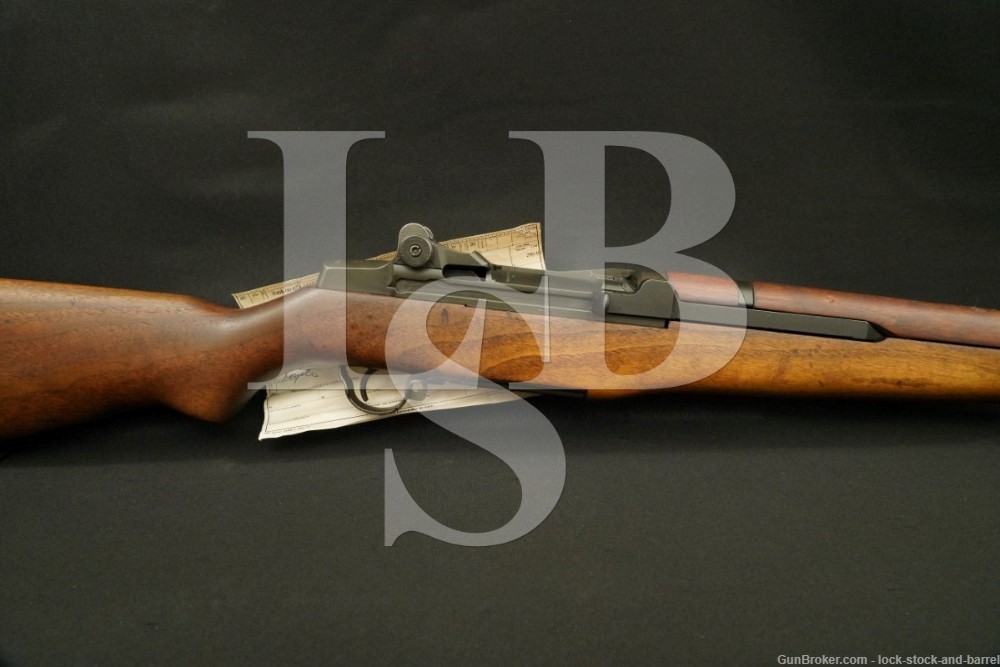
Springfield Armory M1 Garand CMP .30-06 Semi Automatic Rifle MFD 1953 C&R
SOLD FOR: $1375
LSB#: 211002N199
Make: Springfield Armory. This rifle uses all Springfield parts.
Model: M1 Garand.
Serial Number: 4268879
Year of Manufacture: 1952 to 1954. Barrel Date: April, 1953
Caliber: .30-06 Springfield
Action Type: Semi Auto, En Bloc Clip Fed
Markings: The import mark on the bottom of the receiver reads “LITHGOW INC. / SAC. CA.”. This is NOT a Lithgow ADI manufacturer’s mark. This is an import mark. Lithgow ADI made some M1A receivers for the commercial Springfield Armory company.
Receiver: “U.S. RIFLE / CAL. .30 M1 / SPRINGFIELD / ARMORY / 4268879”.
Trigger Group: “6528290-SA”- A Springfield part (page 90 of Joe Poyer’s M1 GARAND 1936 to 1957, 6th Edition).
Hammer: “D5546008”– A Springfield part (page 98).
Safety: “SA-11” –A Springfield part (page 103).
Follower: Unmarked – Used by Springfield and others (page 83).
Receiver Leg: “A73B”, “C”, and “D 6528291-43” – Correct for the Springfield serial number (page 756 of Bruce Canfield’s book, The M1 Garand Rifle).
Op Rod: “D35382 SA” – A Springfield part (page 71).
Barrel: “P”, and “SA D6536448 4 53 A193A”, and with a faded “crossed cannons” stamp – A Springfield part (pages 63 – 65).
Bolt:“6528287 SA / A-11”- A Springfield part (page 53).
The stock and sights are described below.
Barrel Length: Approximately 24 Inches
Sights / Optics: The front sight is a blade set between two protective wings. The rear sight is a fully adjustable aperture sight set between two protective wings. The windage knob is marked “LEFT arrow” twice and “DRC”. The elevation knob is marked from “2-12” in increments of two and “WCE”.
Stock Configuration & Condition: The left side stock, above the trigger, is marked with a restamped Springfield Armory inspector’s cartouche “S.A. / J.L.G.” in a box”, and with a “crossed cannons” cartouche. The inspector’s cartouche is correct for the rifle’s serial number (page 134). The face of the grip is marked with a “circled P” proof.
The hardwood stock has a pistol grip, metal nose caps, a stacking loop, two sling loops, and a metal buttplate with hinged door for storage in the butt. We found rolled up CMP paperwork in the butt. The buttplate shows scratches, surface erosion, and discoloration from oxidation. The wood shows scrapes and compression marks. Some of the marks have damaged small areas of the surface wood. These marks have been oiled. The LOP measures 13 ? inches from the front of the trigger to the back of the buttplate. The stock rates in about Very Good Plus overall condition.
Type of Finish: Parkerized
Finish Originality: Refinished
Bore Condition: The bore is bright; semi bright near the muzzle. There is fouling and intermittent light erosion in the grooves near the muzzle. The fouling should clean up some. The bore shows an M.E. of 0.8. The throat shows a T.E. of 3.
Overall Condition: This rifle retains about 98% of its metal finish as refinished. The meal shows scuffs & handling marks. The barrel and gas tube show light scrapes. The edges of the trigger guard show thinning. The markings are deep. Overall, this rifle rates in about Very Good Plus to Fine condition as refinished.
Mechanics: The action functions correctly. We did not fire this rifle. As with all used firearms, a thorough cleaning may be necessary to meet your maintenance requirements.
Box, Paperwork & Accessories: We found a rolled up receipt from the Civilian Marksmanship Program (CMP) stored in the butt. It is marked on the front & back with the rifle’s serial number in pen. The receipt does not list the CMP by name but lists where the rifle was shipped from “PORT CLINTON, OH”. This is the CMP North Store location. The receipt shows discoloration creasing and a small tear. It is in Good to Very Good condition.
Our Assessment: The U.S. Rifle, Caliber .30, M1 is known affectionately as “the Garand” after its inventor, John Garand. The rifle would become the first standard-issue semi-automatic infantry rifle in the world. While some countries entered the war with limited issued semi-automatic rifles or developed such rifles during the war, America was the only nation to enter with its Army issuing autoloading rifles on a large scale. General Patton famously referred to the rifle as “the greatest battle implement ever devised”. Millions were produced during WWII and hundreds of thousands afterward, seeing use through the Korean War and into the Vietnam War. Interestingly, while many other weapons and military items would see production contracts sent out to otherwise non-related companies, during WWII production remained with Springfield Armory and Winchester. It was only after the war that production would be contracted out to another gunmaker, Harrington & Richardson, as well as the agricultural equipment maker, International Harvester.
This Springfield Armory M1 Garand was built after WWII. It has since been rebuilt & refinished. The rifle uses all Springfield parts including the stock which makes it quite collectible. The rifle still has nice markings on the metal & wood as well as a strong bore.
We found a CMP receipt rolled up & stored in the butt. We also noted an import mark under the receiver. These usually do not go together as CMP Rifles aren’t usually import marked. It appears that the rifle was purchased from the Director of Civilian Marksmanship (DCM) or its later version, the Civilian Marksmanship Program (CMP). At some point after the CMP purchase the rifle was acquired by Lithgow Inc. where it was refinished and import marked. Luckily the import mark is under the receiver so you don’t see it unless you break down the rifle for maintenance. Good luck.

